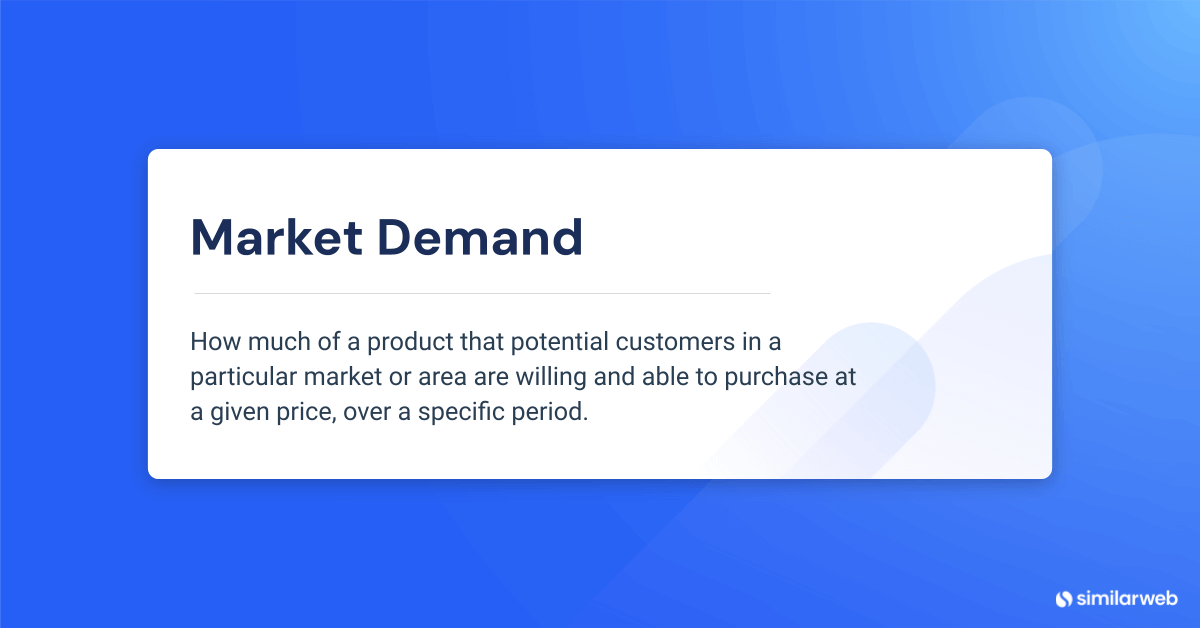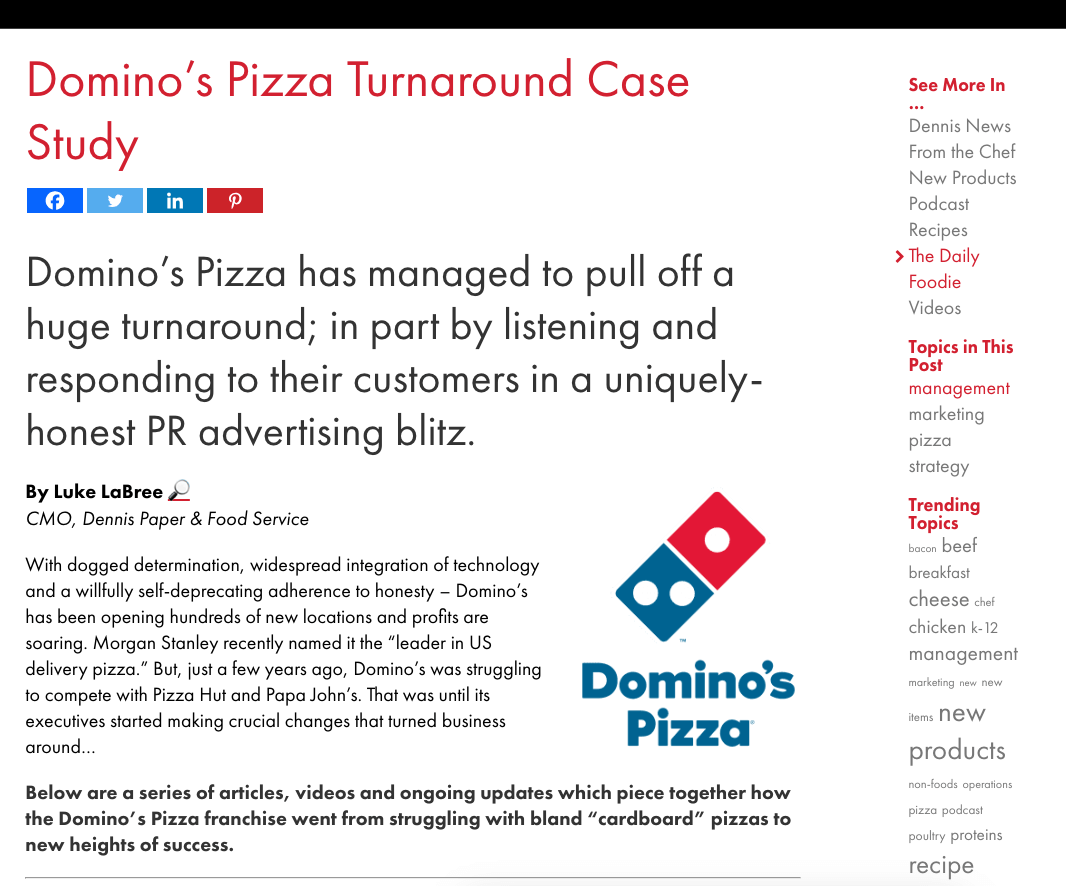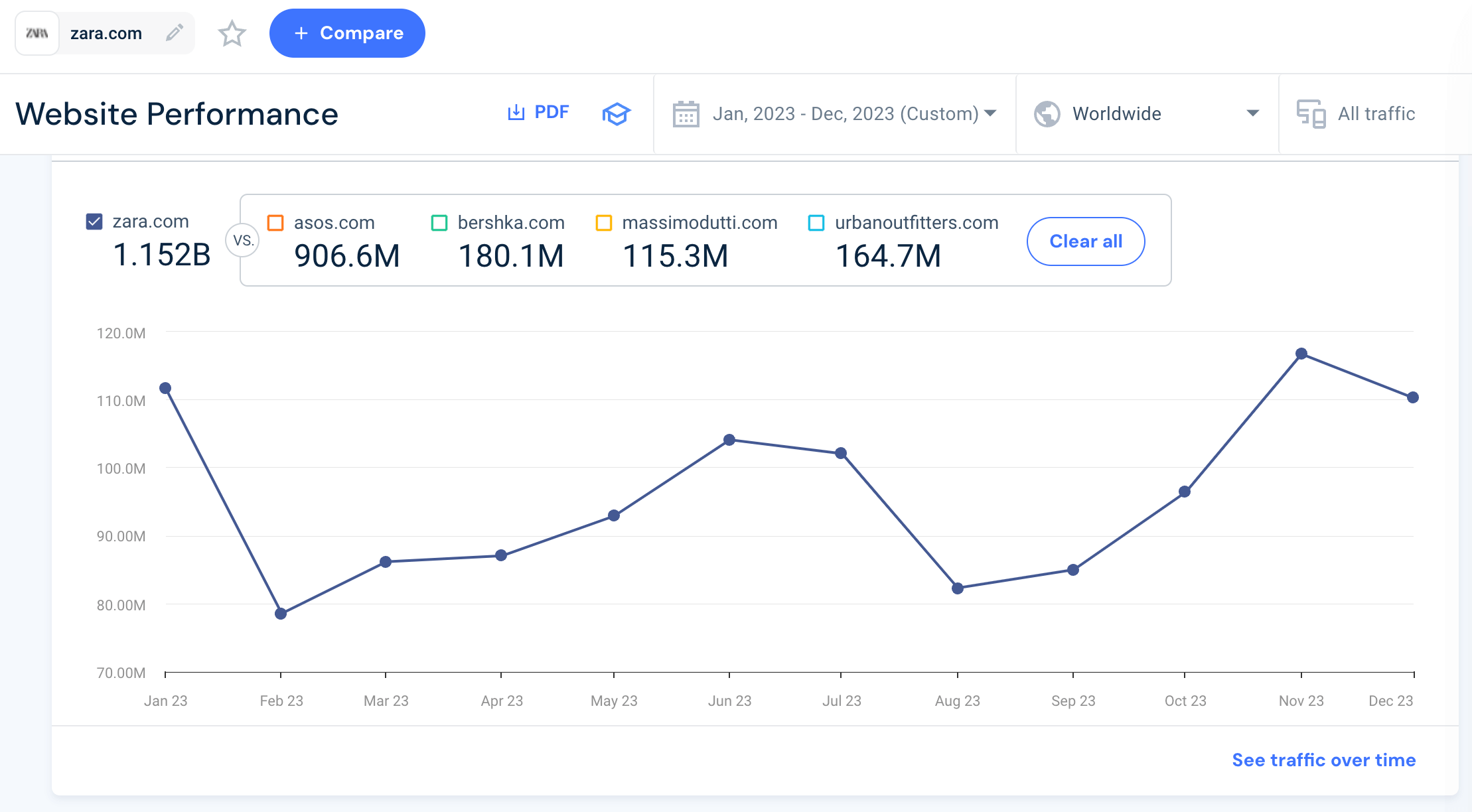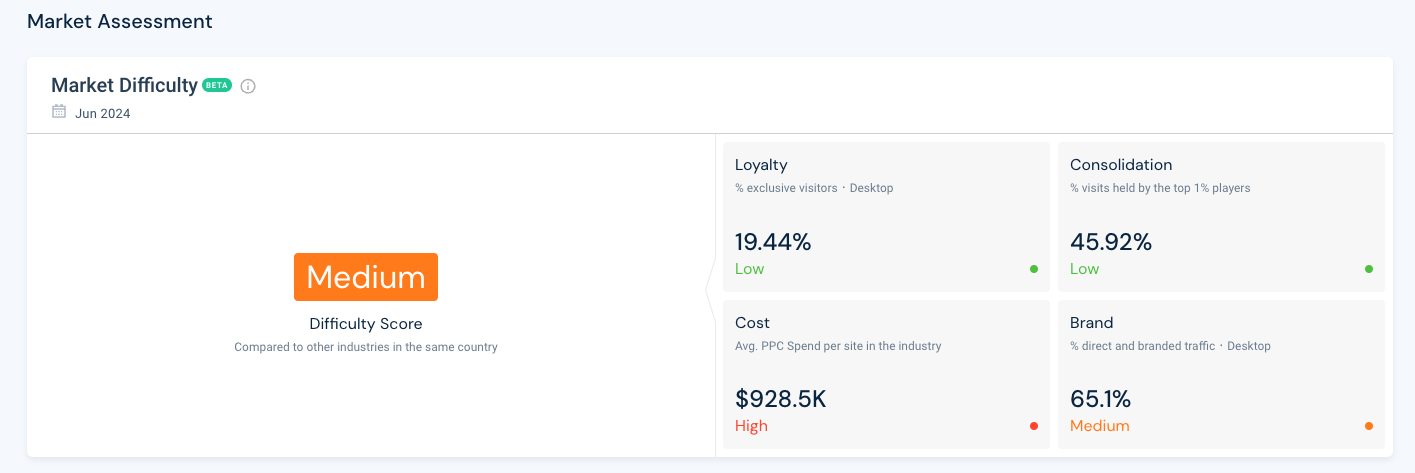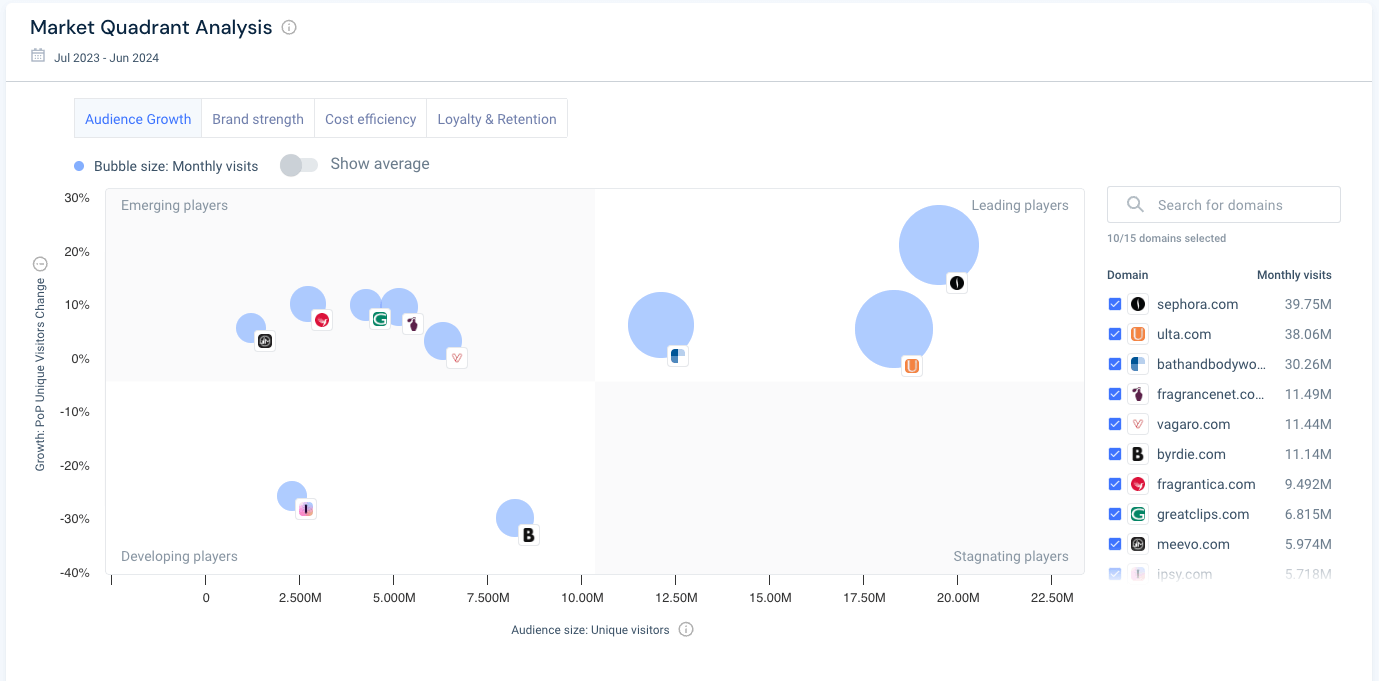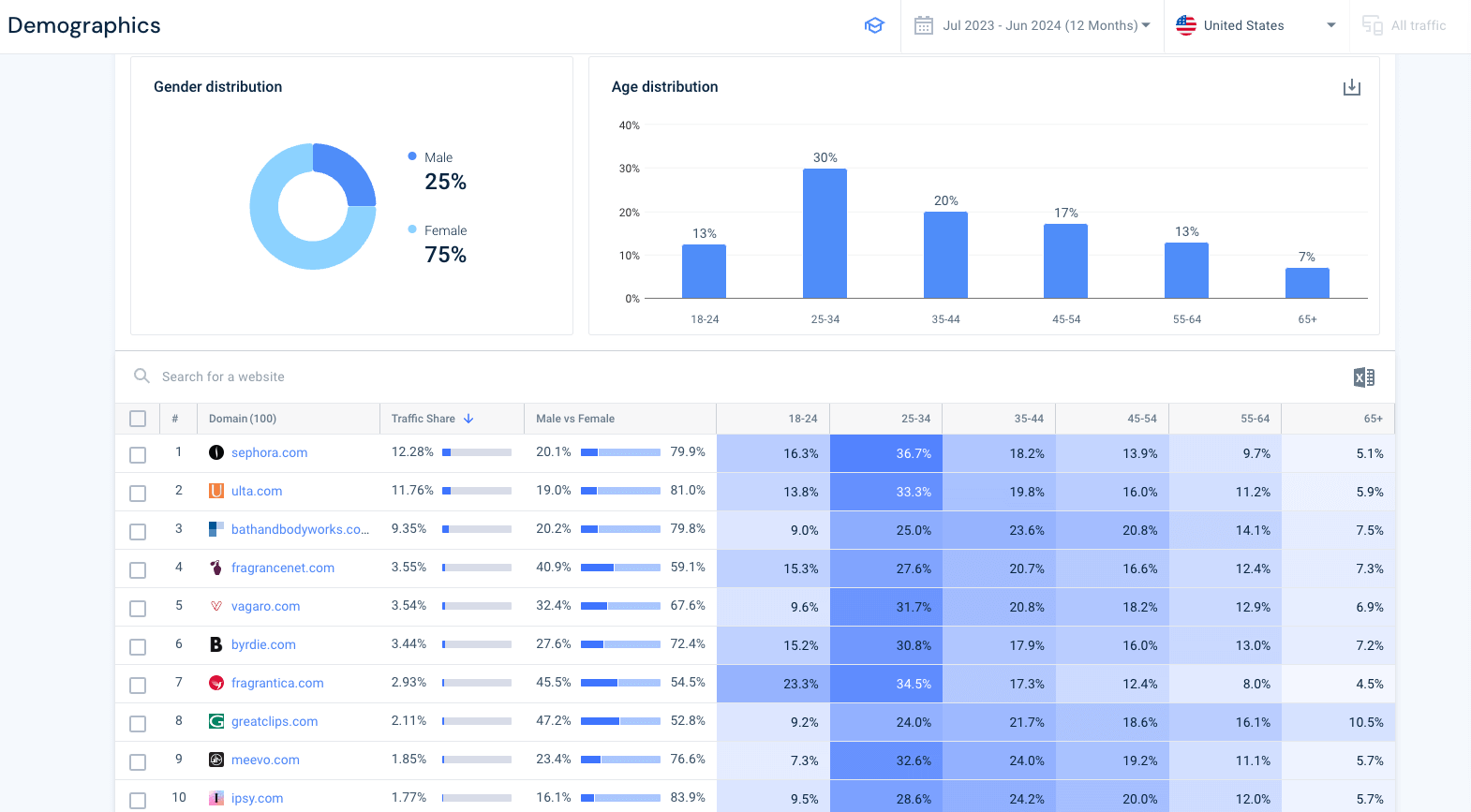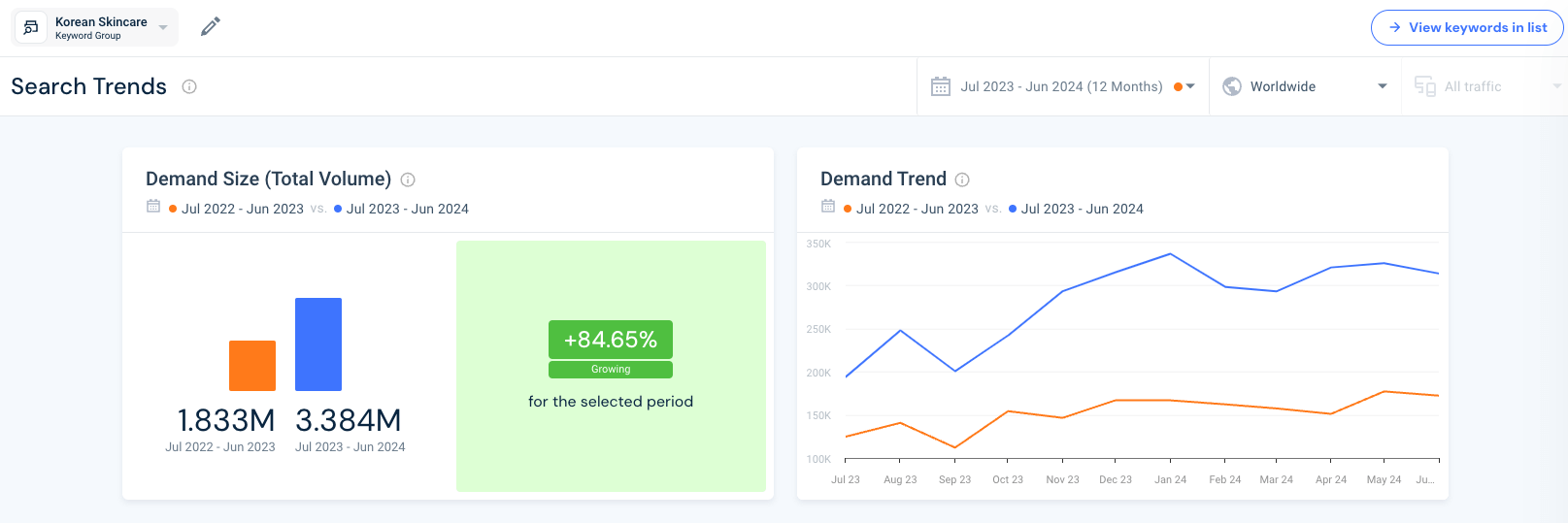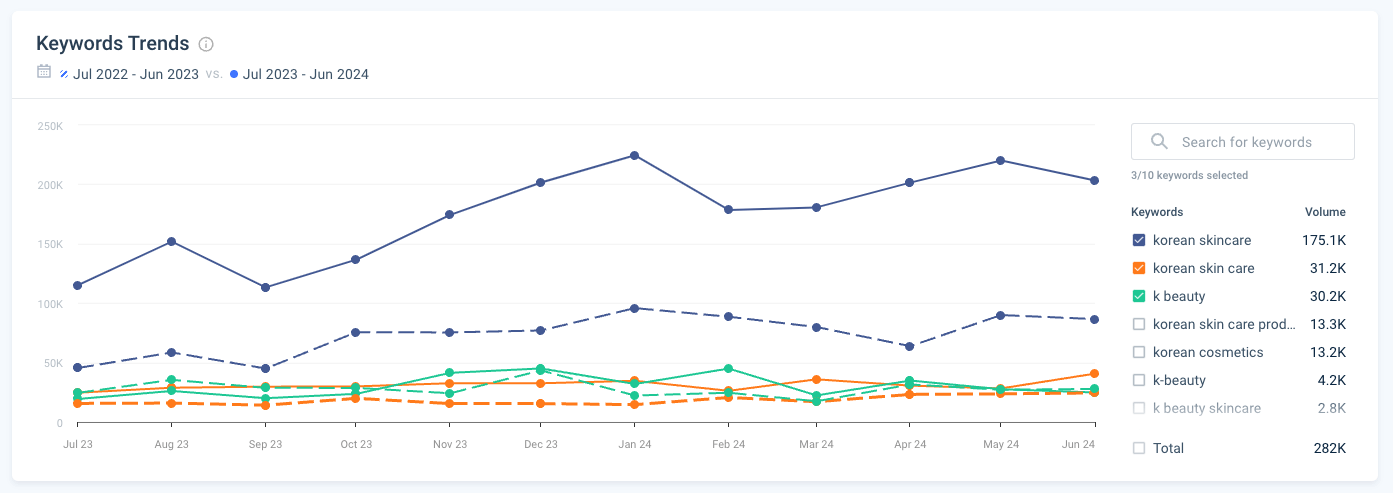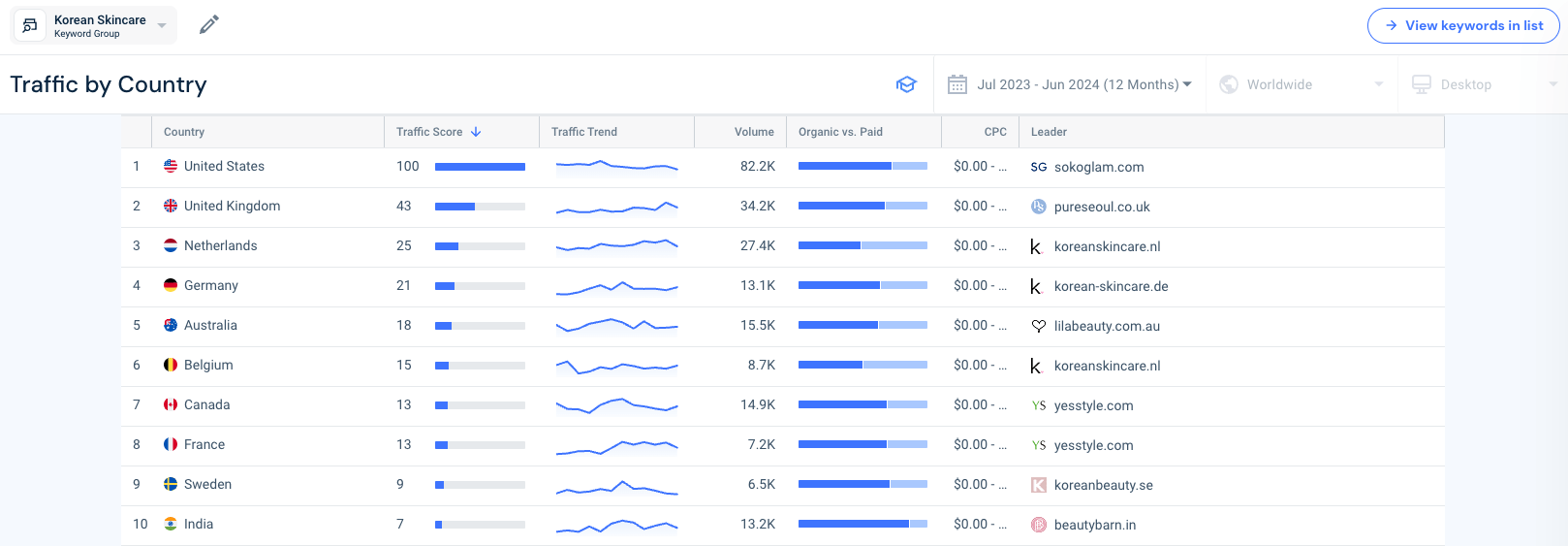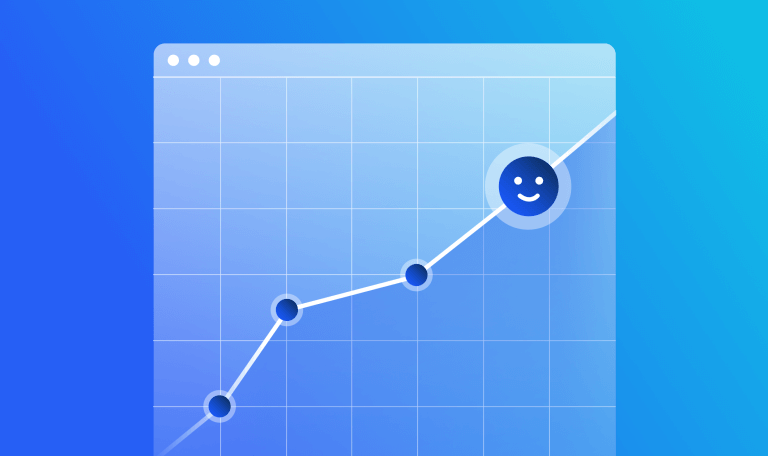Market Demand 101: How to Gauge Demand for Your Products

One sure way to outpace your competitors in an ever-evolving world of changing consumer tastes and preferences? Understand how to gauge market demand for your products.
Why? Because knowing what your customers want and when they want it can mean the difference between sinking and swimming in today’s fast-paced, ultra-competitive landscape.
In this guide, we’ll take you through the ins and outs of market demand – its importance, types, influencing factors, and how to analyze it for your specific products.
And, of course, how to use market research tools like Similarweb to ensure you’re doing it better than all of your competitors.
So, let’s get ready to master gauging market demand 💪
What is market demand?
In the simplest terms, market demand is how much of a product that potential customers in a particular market or area are willing and able to purchase at a given price, over a specific period.
In economic terms, it’s a fundamental principle in helping businesses understand to what extent their products or services are desired by the market.
The most fun part? Market demand fluctuates constantly. This is thanks to many influencing factors that can and will change at any given moment. We’re talking about things like economic conditions, consumer preferences and technology advancements that, as we all know, continuously reshape the market.
Why is market demand important?
You may be hard-pressed to think of something more important than understanding market demand. The bottom line is that if customers aren’t interested in your products, you’ll struggle to make sales, and they’ll be a whole load of money down the drain.
The importance of market demand extends far and wide, underpinning crucial decision-making across the whole business.
Understanding market demand is important for many reasons, including:
1. Allocating resources
When you know which products are in demand, and when, you can allocate resources as efficiently as possible. For example, a retail giant like Amazon will hire seasonal workers during peak periods like Black Friday, Christmas and Prime Day, or a start-up may use market demand to make the most of their limited budgets by prioritizing the development of a feature that users are actively requesting.
2. Determining price
This is thanks to the good old theory of supply and demand. American Airlines, for example, may use market demand to set pricing that maximizes profitability, adjusting ticket prices to reflect that higher demand leads to higher prices and vice versa.
Market demand can also affect pricing strategies in other ways. A retailer like Walmart could use demand data to decide when to offer discounts and promotions on certain products, like on summer clothing towards the end of the season when demand begins to drop off.
3. Strategic planning
Understanding market demand can give you the data-backed confidence needed to make more precise and effective strategic decisions about anything from product production and inventory management to marketing planning.
For example, market demand will help you determine the right quantity of products you need to manufacture and when to ramp up production to meet surges in demand. Similarly, with inventory management, market demand ensures you have the right amount of stock, saving you from costly excesses or missed opportunities caused by shortages.
4. Minimizing risk
Getting a grip on market demand for your products can really help you anticipate future changes in the market, helping you to minimize risks and react proactively.
This could be anything from promoting lower-cost products during times of economic downturn, or knowing when to enter a new market. For example, Starbucks will leverage demand analysis to decide whether to open a new store in a new location, reducing the risk of a failed expansion.
Types of market demand
To help businesses with the nuances of demand, there are several different types of market demand that can be applied to specific market conditions. These include:
Primary demand: refers to the total demand for all brands within a product category, driven by overall customer interest rather than interest in a specific brand.
This can help when a business wants to increase the overall market size, most relevant for an emerging industry where the goal is to attract more consumers to the category itself. An example could be electric cars. Brands will want to first focus on boosting interest in electric cars over gas cars, rather than their specific brand of EVs.
Selective demand: the demand for a particular brand within a category, driven by brand identity, customer loyalty and marketing strategies.
This helps businesses understand when to invest in building up their brand and emphasizing their product’s USPs with targeted marketing campaigns.
Seasonal demand: the type of demand that fluctuates based on seasons change or specific events of the year, driven by weather, holidays, events and other predictable cycles of demand.
Businesses can plan inventory and marketing strategies around seasonal peaks and troughs, or offer seasonal promotions and adapt product lines to suit changing seasonal preferences.
Latent demand: a type of potential demand that hasn’t been fully realized yet, driven by unmet needs and desires but hindered by lack of innovation or favorable market conditions
This is a tricky situation for businesses to address. It involves identifying and tackling whatever barriers are stopping the customers from realizing the demand for the product. They must innovate and get creative to meet latent demand.
A good example of this is home automation systems, which for a long time lacked the technology and accessibility to properly enter the market. With the launch of affordable options like Amazon Alexa and Google Home, the latent demand was overcome.
Negative demand: when the majority dislikes/doesn’t resonate with a product and avoids buying it.
Another difficult nut to crack. To overcome negative market demand, businesses need to focus on addressing the driving factors behind it. Why don’t people respond to my brand or product? This is usually achieved through rebranding efforts, improving product quality,or attempting to change public opinion with targeted, strategic marketing.
A good example of this was when Domino’s launched its “Pizza Turnaround’ campaign in 2009 to address the fallout after a video was released of some employees handling the food in a questionable manner.
When their reputation took a hit and sales dropped, Dominos chose to face the music instead of waiting for it to blow over. They released a branded documentary video that addressed several customers’ complaints about the quality of their pizza head-on, with an air of complete honesty and transparency.
And, it worked. Domino’s has been at the top of the pizza chain charts in the US since 2017, with a revenue of $4.53 billion in 2022.
Derived demand: demand for a product directly influenced by the demand for another product, like demand for tires driven by demand for cars.
Businesses can navigate this type of demand by understanding the relationship between the connecting products to predict and respond to any changes in demand effectively.
What can influence market demand?
It can be hard to keep track of all the aspects that can influence demand for your products. However, here’s a quick look into some of the biggest factors that can help you predict and respond to demand changes more effectively:
💸 How much a product costs – higher prices tend to lead to a dip in demand and vice versa
🤑 Disposable income – as consumer incomes increases, the demand for products generally goes up, too
👑 Changing consumer preferences and tastes – customers can quite literally change their preferences overnight!
🌟 The availability of substitute goods-– substitute products can reduce demand for a specific product
✨ The availability of complementary goods – demand for complementary goods can cause demand for related products to rise alongside it
📈 Market trends – emerging trends and technological advancements can directly influence demand patterns
💡 The strength of marketing efforts – effective marketing strategies can boost demand
💲 The state of the economy – periods of stability or instability can hugely affect consumer purchasing power and, therefore, demand for products
Market demand examples
Technology
Are you eagerly awaiting the newest iPhone? You’re certainly not alone. Because of this, demand for smartphones often peaks with the release of new models by tech giants like Apple, and Samsung, driven by intense consumer anticipation and a whole lot of marketing hype.
Indeed, every time Apple launches a new and improved iPhone, it’s a prime example of how selective demand plays out in the tech industry.
Every year there’s a huge buzz created around its launch, sparked by many teasers and announcements about all the snazzy new features. Often anticipation can be so high that customers will wait for the new release before upgrading.
This is mostly thanks to Apple’s super loyal customer base, top-notch marketing strategies and consistency in producing new innovative features and improvements. All of this ensures that the demand for the latest iPhone always peaks around its launch.
Recent example:
Apple’s campaign for the iPhone X was an absolute masterclass in creating hype and demand. The company highlighted revolutionary features like Face ID and the edge-to-edge OLED display through high-impact advertisements, social media buzz and live demonstrations during their keynote event. This campaign not only generated immediate sales but also reinforced Apple’s position as a market leader in innovation.
Seasonal fashion
This is one you can’t help but notice. Seasonal demand is a clear driver within the fashion industry, with winter collections naturally being more in demand during the colder months and summer collections gaining traction during warmer weather.
Above, you can see that traffic to zara.com gradually increased from March 2023, peaking in June, before dropping just before autumn – only to then peak again around the holidays – hello party dress season!
Clothing stores like Zara are a perfect example of effective management of seasonal demand. Every few months, Zara releases new collections in line with both seasonal peaks and emerging fashion trends. This constant renewal keeps the brand fresh and in demand throughout the year.
Zara’s agile supply chain allows for rapid response to seasonal changes and fashion trends, making sure that in-demand products are available at the right time. This helps keep inventory and stock levels well-balanced to optimize sales and minimize waste. Also, their effective marketing strategies help emphasize the latest trends, encouraging customers to update their wardrobes with each season.
Electric cars (EVs)
A great example of demand influenced by customer preferences and trends is the demand for electric cars, such as Tesla and Rivian, which has surged due to things like increased environmental awareness, cutting-edge technology, and government incentives.
Let’s take Tesla, which has been at the forefront of the electric vehicle revolution, and the launch of the Tesla Model 3. In 2017, Tesla released the Model 3 alongside a very effective campaign – led by founder & CEO Elon Musk on stage – that highlighted the affordability, range and innovative features of the new electric car. As part of the campaign, they leveraged online reservations, direct sales, and strategic partnerships to drive up a high level of pre-launch demand.
The combination of rising environmental consciousness, favorable policies and Tesla’s innovative approach has led to a significant shift in consumer preferences towards electric vehicles. Tesla’s marketing campaigns effectively highlight the benefits and unique selling points of their EVs, driving strong market demand.
How to find market demand with Similarweb
Now that you know what market demand is, let’s walk through the two main steps you need to take to do it effectively.
Step 1: Gauge the market
First things first. Get to grips with your market and your place in it.
When you analyze the broader category, you can better understand the context in which your product exists. We’re talking trends, consumer behaviors and other market dynamics that we’ve already discussed can really impact market demand.
But, where to start? As a guide, here’s how you can analyze your market using Similarweb’s Market Analysis module:
1. Assess market size
Begin by assessing the overall market size of your product’s category. As an example, we’ll zone in on the Beauty and Cosmetics industry in the US.
Here, you can gauge some key sizing indicators such as total visits to websites within the Beauty and Cosmetics industry from a select period (for example, over the last 12 months) and see the year-over-year (YoY) change. There are also key metrics like ‘visits per visitor’ or ‘pages per visit’ to use as industry-standard benchmarks.
2. Identify leaders
Next, get a feel for the global competitive landscape. Find out which brands are killing it and which global markets are getting the most traffic by reviewing the market share breakdown:
When it comes to the top players of the Beauty and Cosmetics industry, there are very few surprises here. But it’s certainly interesting to see which markets are on the rise – Japan saw a 17% uplift over the last year, and Brazil’s market share grew by just over 10%.
This is a great way to find geographic hotspots where demand for your product may be growing, so you can get ahead and strategize your marketing efforts accordingly.
3. Assess any barriers to entry within your market
Build out your understanding of how difficult it is to compete within your wider industry under Market Assessment, where you’ll find its ‘Difficulty Score’. This is based on several metrics including market saturation, customer loyalty, the strength of branded traffic and other barriers to entry.
As you can see, the Beauty and Cosmetics industry has a medium Difficulty Score suggesting that it’s possible to gain market share with a carefully considered product and marketing strategy.
For example, it appears that customer loyalty is low in this category, which means that 80% of people who visit one beauty brand are likely to go on to visit several others.
But it’s also important to understand that 65% of traffic comes from direct and branded searches, showing that having a strong brand identity is also important in this industry. It might be worth spending a few extra bucks on advertising to raise brand awareness.
4. Identify risers and declining players
Seeing which brands are on the rise, and which are declining in popularity, within the wider industry is a great way to understand what type of products have been resonating with your audience over the past year.
For example, skincare brand With Agency has seen a 270% increase in unique visits since July 2023, showing a keen and growing interest in anti-aging skin care. Another anti-aging skincare brand, Laura Geller, makes the top 5 with an uplift of 117% YoY.
5. Get to know your competitors
Another key step in understanding the competitive landscape is assessing the brand strength of top players in your industry or segment.
Our Market Quadrant Analysis illustrates the performance of the top players based on key metrics for easy comparison (and business benchmarking):
Here, you can dive into juicy competitive data surrounding their audience growth (growth in unique visits vs. audience size), brand strength (branded search volume vs. direct traffic), cost efficiency (PPC spend vs. change in visits) and loyalty and retention (number of returning visitors vs. exclusive visitors)
This can help point you to the brands that have the most in-demand products and are masters at growing and retaining their customer base.
6. Audience demographics
Naturally, an important part of understanding the demand for your products is understanding your audience, who are key drivers of that demand. You’ll find a host of audience data to dive into under our Demographics section:
Here, you can see that the Beauty and Cosmetics industry has a predominantly female audience of 75%, and 30% are over the age of 45.
This may suggest that, while the bulk of product assortment and marketing should be geared towards Millenial and Gen Z audiences, there is a lot of opportunity to unlock with the 45+ demographic – as we can clearly see with the rising popularity of anti-aging skincare products and brands.
Step 2: Gauge current demand for a topic
1. Check out the demand for topics related to your products
Now we’re getting to the nitty-gritty. The first thing to look at is whether demand for the relevant topic is growing using Similarweb’s Demand Analysis module.
Let’s narrow down our Beauty and Cosmetics example and hone in on the topic of Korean Skincare.
Start by uploading a list of relevant keywords into the tool. This will generate an overview of the general interest in this topic to show whether it is growing, stagnating, or declining:
Here, you can compare demand between 2023-2024 with the previous year to see how it’s changed. As you can see, demand for Korean skincare has skyrocketed by 84% within this period.
For a more visual look at the trajectory of demand, you can also refer to Similarweb’s Demand Trend graph. This can be very helpful in pinpointing any changes in seasonal demand. In fact, we can see that there was a slight dip in demand during September 2023 and again in February 2024 which would be worth investigating.
2. Keyword trends
Next, it’s time to see which keywords are driving the demand trends. This is so you know which keywords to use to optimize your SEO, content and paid advertising strategies to drive more traffic to your website and product listings going forward.
Diving deeper, you can check out the Keywords Trend Summary, which gives a more detailed breakdown of the top search terms within the topic.
For example, we can see that the keyword volume for ‘Korean face care products’ has grown by over a whopping 2000%. But, search terms that feature ‘k-beauty’ are experiencing either slower growth or declining.
What’s keyword research without some marketplace intelligence? Using Similarweb’s Shopper Intelligence platform, you can get the hottest keyword data straight from Amazon:
Here, you can review what Amazon shoppers are actively searching for in your category. Check out the % change in clicks over the selected time period to gauge how demand is changing for products.
For example, ‘bubble skincare’ experienced a 592% increase in clicks YoY, suggesting that their gentle, simplified skin care products have really resonated with consumers, particularly the younger generations.
3. Traffic by country
As mentioned above, it’s important to pinpoint geographical hot spots of demand for your chosen topic. You can do this under the Traffic by Country section:
The difference here compared with the data found in Market Analysis, is that you can see where in the world traffic from either organic or paid search (or both together) is coming from for this topic.
You can use the organic vs. paid split to determine whether you need to invest more money in advertising in some global markets that have a higher percentage of paid traffic – like the Netherlands and Belgium.
To wrap things up: It’s time to deliver on demand
In today’s fierce market, understanding market demand is not just beneficial, it’s essential. We’ve learned that market demand involves knowing how much of your product customers are willing to buy at a given time and price. Recognizing its importance will help you allocate resources efficiently, determine pricing strategies, plan strategically, and minimize risks.
Hopefully, this guide has highlighted how critical it is to stay ahead of the curve by constantly monitoring and adapting to market demand.
Enter Similarweb! Our tools are designed to help you delve deep into market trends, analyze competitor performance, and understand audience demographics with unparalleled ease. This insight allows you to make data-driven decisions, ensuring you stay ahead of the competition and meet your customers’ needs precisely when they arise.
Because with Similarweb, you’re not just keeping up with market demand, you’re mastering it.
FAQs
What is the definition of market demand?
Market demand is the total amount of a product that potential customers in a specific market are willing and able to purchase at a given price over a specific period. It helps businesses understand how much their products are desired by the market, providing crucial insights into consumer interest and potential sales.
What are the different types of market demand?
There are several types of market demand depending on specific market conditions. Primary demand refers to the total demand for all brands within a product category. Selective demand is the demand for a specific brand within that category. Seasonal demand fluctuates based on seasons or events, while latent demand is potential demand that hasn’t been fully realized due to unmet needs or market conditions. Negative demand occurs when the majority dislikes or avoids a product.
What sort of factors influence market demand?
Several factors influence market demand, including the price of the product, as higher prices generally lead to lower demand. Disposable income also plays a role, as higher consumer income usually increases demand. Consumer preferences, which can change quickly, and the availability of substitute goods can affect demand as well. Complementary goods, market trends, marketing efforts, and economic conditions also significantly impact market demand.
How can Similarweb help me gauge market demand for my products?
Similarweb’s Market Analysis and Demand Analysis tools can gauge market demand for your products by helping you analyze market trends, understand competitor performance, assess demand for relevant topics and identify key audience demographics. By leveraging our data, you can make informed decisions, optimize your marketing strategies, respond to changing consumer preferences and stay ahead of your competitors.
Track your digital metrics and grow market share
Contact us to set up a call with a market research specialist
